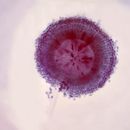Brief Summary
provided by EOL authors
Aspergillus niger is a member of the genus Aspergillus which includes a set of fungi that are generally considered asexual, although perfect forms (forms that reproduce sexually) have been found. Aspergilli are ubiquitous in nature. They are geographically widely distributed, and have been observed in a broad range of habitats because they can colonize a wide variety of substrates. A. niger is commonly found as a saprophyte growing on dead leaves, stored grain, compost piles, and other decaying vegetation. The spores are widespread, and are often associated with organic materials and soil. The primary uses of A. niger are for the production of enzymes and organic acids by fermentation. A. niger is also used to produce organic acids such as citric acid and gluconic acid.
Morphology
provided by EOL authors
While morphology provides a reasonable means of classification and assignment within the A. niger group, it is not a reliable means for identifying a given isolate from the field. The major distinction currently separating A. niger from the other species of Aspergillus is the production of carbon black or very dark brown spores from biseriate phialides (Raper and Fennell, 1965). Other features include the smooth and generally colorless conidiophores and spores that are ó5 æm, globose, and have conspicuous ridges or spines not arranged in rows. A. niger isolates grow slowly on Czapek agar (Raper and Fennell, 1965). These physical characters such as spore color and rate of growth on a defined media are subject to change, especially under extended pure culture or selection and mutation. Though A. niger is relatively stable to spontaneous mutation compared to other aspergilli, variation in morphology may still be a problem with some strains (Raper and Fennell, 1965). Thus this species may be misidentified with other Aspergillus spp.
Risks
provided by EOL authors
Aspergillus niger is worldwide in distribution and has been isolated from numerous habitats. Humans are continually exposed to A. niger spores and vegetative forms on foodstuffs and in the air. The vast majority of strains of A. niger, especially those used in industrial fermentation, have a history of safe use. While there are sporadic reports to the contrary, most isolates have not been documented to be serious pathogens of humans, animals or plants. Specific strains may produce certain mycotoxins or may elicit allergic responses among workers. Those limited instances of adverse effects seem to be associated with a limited number of strains. With proper characterization of industrial strains, use of those with potential for such effects can be avoided.

